
Journal of Perioperative & Critical Intensive Care Nursing
Open Access
ISSN: 2471-9870

ISSN: 2471-9870
Research Article - (2021)Volume 7, Issue 1
Background: Valvular heart diseases (VHD) are significant cause of mortality and morbidity globally with rheumatic heart disease (RHD) contributing to major burden in India. Management of progressive VHD requires mechanical or bioprosthetic valve replacement. Mechanical valve replacement requires lifelong anticoagulation which carries the risk of serious bleeding and thromboembolic events unless INR is maintained within the prescribed narrow therapeutic range. Effectively managing the determinants of INR control like patient education, drug- adherence, lifestyle habits, drug and food interactions and frequency of INR monitoring can help improve patient outcome.
Aim: To assess the effect of structured patient education programme on knowledge regarding anticoagulation therapy and INR Control among patients undergoing mechanical valve replacement.
Materials and methods: This quasi-experimental study was conducted among 60 admitted adult patients undergoing valve replacement surgery. Structured patient education programme was provided to the experimental group whereas control group had routine care. The baseline knowledge of both groups was assessed using a self-structured questionnaire preoperatively and post-intervention knowledge was assessed at 1-month follow-up. INR values of the patients were recorded at 7 days and 1-month follow-up.
Results: Majority of the patients in both groups (87 versus 83.3%) had poor knowledge regarding anticoagulation therapy at baseline. Median knowledge score of patients improved significantly (p<0.05). The proportion of patients within therapeutic range of INR in the experimental group was higher (23.3%) at 1-month follow-up as compared to 13.7% in the control group which was statistically not significant (p-0.59). Higher knowledge score was associated with higher monthly income and urban residence.
Conclusion: Structured patient education programme significantly improved the knowledge of patients regarding anticoagulation but had no significant effect on INR control. Patient education programme should be implemented in hospital settings in order to improve patient outcome. Keywords: structured patient education programme, anticoagulation knowledge, INR Control, mechanical heart valve replacement.
Structured patient education programme, Anticoagulation knowledge, INR control, Mechanical heart valve replacement
VHD is a major cause of morbidity and mortality worldwide. In India, the prevalence of RHD in school going children between 1948 and 1983 varied from 1.8 to 11 per 1000 (national average 6/1000) whereas the prevalence was 1 to 5.4 per 1000 in the years 1984 to 1995 [1]. Valvular disease is a progressive disease and often requires surgery when it is serious and/or patient is symptomatic [2]. Approximately ten thousand patients undergo valve replacement in India every year. Anticoagulation is the most important aspect of prosthetic valve follow-up. 32% of patients after valvular surgery did not maintain regular follow-up [3]. Warfarin-related haemorrhage is actually the single most common drug-related cause of hospitalization (33.3%) for adverse events among older adults in the USA [4]. The yearly incidence of major bleeding during anticoagulation therapy is 2%-5%, fatal bleeding is 0.5%-1% and for intracranial bleeding is 0.2%-0.4% [5]. Obstructive prosthetic valve thrombosis occurs at a rate of 0.3– 1.3% patient-years in mechanical heart valves [6]. The incidence of thromboembolic complications, including systemic emboli, occurs at a rate of 0.7–6% patient-years [7]. The chances of occurrence of prosthetic heart valve thrombosis are highest during the first year after the surgery [8]. In order to prevent these complications, anticoagulation control is important which requires frequent blood tests to check prothrombin (PT) time and International normalized ratio (INR). But most of the patients taking warfarin do not maintain stable INR values [9]. Various patient-related factors like female gender, smoking, comorbidities, concurrent medication use and medication knowledge and adherence contributed to the anticoagulation control [10,11]. Changes in warfarin dosage are also contributed by genetic variability of CYP2C9 and VKORC1 [12]. A study conducted in China showed that <50% of patients correctly answered the questions regarding their warfarin therapy and higher the knowledge score better was the INR control [13]. Patients who manage their therapy by themselves are more likely to be in the therapeutic range of INR and have lower complications and hospital admissions than those who donot [14].
The dark side of life-saving anticoagulation therapy is that it leaves the patient at high risk of developing thromboembolic and bleeding complications. Most of the patients who didn’t maintain INR control are also non-adherent to the therapy with one of the main cause being not understanding the necessity of anticoagulation therapy. Medication non-adherence is an area of growing concern within health care, particularly in the management of chronic diseases. Around 50% of patients do not adhere to their treatment. Providing adequate education reduces non-adherence among patients. Also, a study conducted by Anu Alphonsa et al [15] in AIIMS, New Delhi (2014) concluded that only 30% of patients have their recent INR within the target range and 50% of the patients had a poor knowledge score regarding their anticoagulation therapy. RC Moss et al [16] conducted a study and showed that nurse-led structured educational programme was superior to the standard care as it significantly improved the knowledge regarding anticoagulation therapy at discharge and 3 months post discharge; also there was higher patient satisfaction and time spent in the therapeutic range of INR among patients who received the educational intervention.
In present setting, no structured one to one teaching sessions are carried out by health care professionals for anticoagulated patients even when majority of the patients lack adequate knowledge and INR control. This highlights the need for an educational intervention to improve patient outcome.
Quasi-experimental design was chosen. The sample size was calculated based on Baysal et al [17], considering post-test knowledge in intervention group 22.5±3.7 and in control group 16.2±6.4 with a 5% level of significance and 90% power, the estimated sample size was calculated to be 18, and considering 20% dropout rate, 30 patients were estimated to be the sample size in each group. Inclusion criteria were as patients aged more than 18 years, admitted for mechanical valve replacement surgery for the first time. Suffering from any chronic and mental illness was kept as exclusion criteria. Subjects were selected conveniently. Tools used were as subject data sheet, clinical profile, Anticoagulation knowledge assessment questionnaire. Subject data sheet collects information related to age, gender, educational qualification, occupation, religion, any comorbidities, any medication’s use, distance of health facility from home. Clinical profile questionnaire collects information related to BMI, smoking history, alcoholism, and medication use, any comorbidities, hospital stay, and target INR. Both these tools were developed by the researcher under the guidance of medical and nursing faculty. Anticoagulation knowledge assessment questionnaire was a structured questionnaire to assess the knowledge regarding anticoagulation therapy which consists of 25 multiple choice questions. It has 7 domains: Domain1- General Information Domain2- Drug dosing Domain 3- Food interactions Domain4- Drug interactions, Domain5- Adverse events, Domain6- INR monitoring Domain7- Others Knowledge scoring were as Good- 19-25 Average- 11-18 Poor- ≤10. This tool was self developed by researcher under the guidance of medical and nursing faculty internal consistency of the tool is 0.78. Ethical permission was obtained. Confidentiality and anonymity of the subjects were maintained.
Intervention
Structured teaching education programme- consists of an information booklet on anticoagulation therapy regarding: Reason for starting oral anticoagulation therapy, risk and benefit of oral anticoagulation therapy, importance of periodic INR measurements and anticoagulation control, importance of medication adherence, interactions with drugs, food, alcohol and smoking and INR monitoring chart. Each teaching programme was provided on one to one basis and was of 30 minutes. It was conducted preoperatively and reinforcement was given at discharge and at subsequent follow-up at 7 days, 01 month and as and when required. Patients fulfilling inclusion criteria were selected, randomly assigned into experimental and control group, consort diagram shown in Figure 1. Subjects filled the baseline questionnaire. Following which the experimental group was provided with structured teaching education programme. At discharge and at 1 month, reinforcement was provided by discussing the important points about their anticoagulation therapy and clarifying their doubts. Then after 1-month, the same questionnaire was provided to assess the post-test knowledge regarding anticoagulation. INR values were checked at 7 days and 1-month follow-up for both the groups.
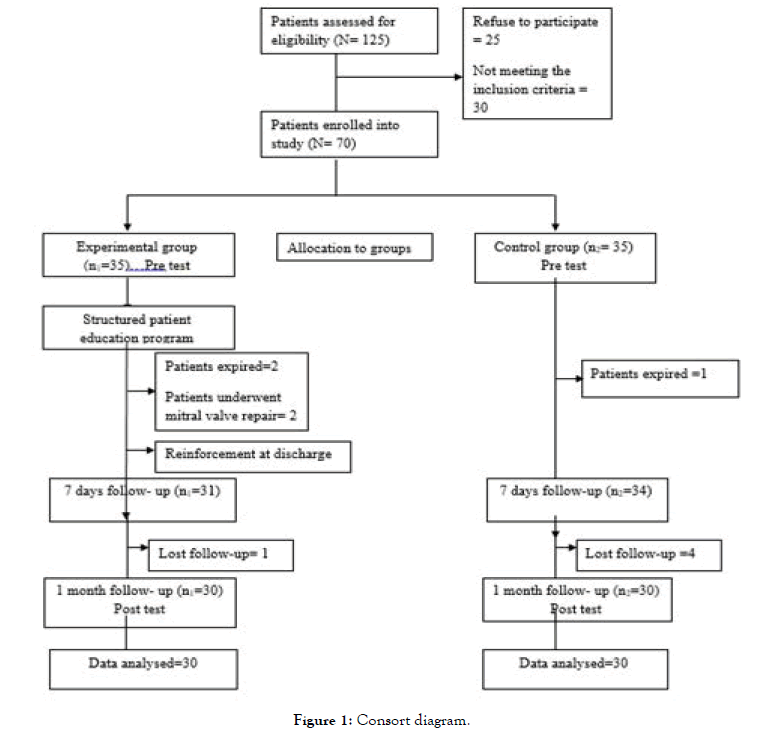
Figure 1. Consort diagram.
Data management and analysis
Data was analyzed using STATA version 14.1. Descriptive statistics (mean, standard deviation, percentage, frequency) and inferential statistics as Mann-Whitney test, Wilcoxon signed rank test were used to compare median scores and t-test, fisher’s exact, chi-square was used to establish associations. The level of significance was taken as <0.05.
The mean age in experimental group was 41.1± 10.9 and control group was 41.8± 13.7. Groups were comparable in terms of demographic (Table 1) and clinical profile (Table 2)
| Demographic Variables | Experimental Group (n1=30) | Control Group (n2=30) |
p value | |
|---|---|---|---|---|
| Mean± SD | Mean± SD | |||
| Age (yrs) | 41.1± 10.9 (20, 65) |
41.8± 13.7 (19,67) |
0.59& | |
| Frequency (%) | Frequency (%) | |||
| Gender | Male Female |
18(60) 12(40) |
15(50) 15(50) |
0.43# |
| Education | Illiterate Primary Education Secondary Education Graduation |
3(10) 5(16.7) 13(43.3) 9(30) |
7(23.3) 8(26.7) 9(30) 6(20) |
0.32$ |
| Monthly income(Rs.) | <5000 | 10(33.3) 14(46.7) 4(13.3) 2(6.7) |
7(23.3) 19(63.3) 4(13.3) 0(0) |
0.39$ |
| 5001-15000 15001-30000 >30000 |
||||
| Marital status | Unmarried Married Widow/Separated |
2(6.7) 28(93.3) 0(0) |
3(10) 27(90) 0(0) |
0.99$ |
| Place of residence | Rural Urban Semirural |
20(66.7) 8(26.7) 2(6.7) |
19(63.3) 8(26.7) 3(10) |
0.99$ |
| Median(min-max) | Median(min-max) | |||
| Distance from health facility (km) | 1000 (10, 1500) |
900 (25, 1500) |
0.38@ | |
Table 1: Demographic characteristics of experimental and control group, N=60.
| Clinical Variables | Experimental Group (n1=30) | Control Group (n2=30) | p value | |
|---|---|---|---|---|
| Frequency (%) | Frequency (%) | |||
| BMI (kg/m2) | <18.5 18.5-24.9 25-29.9 30-39.9 >40 |
8(26.7) 12(40) 7(23.3) 3(10) 0(0) |
5(16.7) 19(63.3) 5(16.7) 1(3.3) 0(0) |
0.34$ |
| Smoking | Yes No |
8(26.7) 22(73.3) |
5(16.7) 25(83.3) |
0.53$ |
| Alcohol | Yes No |
5(16.7) 25(83.3) |
5(16.7) 25(83.3) |
0.99$ |
| Any Co-morbidities | Yes No |
13(43.3) 17(56.7) |
11(36.7) 19(63.3) |
0.59# |
| Any medication use | Yes No |
14(46.7) 16(53.3) |
10(33.3) 20(66.7) |
0.29# |
| Target INR | 2.0-3.0 2.5-3.5 |
4(13.3) 26(86.7) |
4(13.3) 26(86.7) |
0.99$ |
| Mean±SD | Mean±SD | |||
| Hospital stay (days) | 10 ± 3 (6,20) | 13± 5 (7,28) | 0.99& | |
Table 2: Clinical variables of the experimental and control group.
Effectiveness of structured patient education programme on the knowledge regarding anticoagulation among patients undergoing mechanical valve replacement
Majority of the subjects in experimental group (87%) and control group (83.3%) had poor pretest knowledge regarding anticoagulation and none of them had good pretest knowledge. (Figure 2) The baseline knowledge scores of both the groups were comparable (p-0.99). In post-test, Majority of the subjects in experimental group had good knowledge score (63.3%) followed by average knowledge score (36.7%), while, majority of the subjects in control group had poor knowledge score (83.3%) followed by average knowledge scores (16.7%) (Figure 3). The difference in the post-test knowledge level was statistically significant at p-value 0.00.
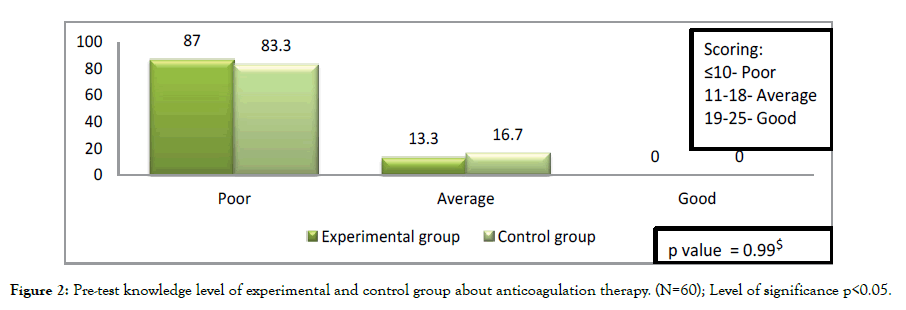
Figure 2. Pre-test knowledge level of experimental and control group about anticoagulation therapy. (N=60); Level of significance p<0.05.
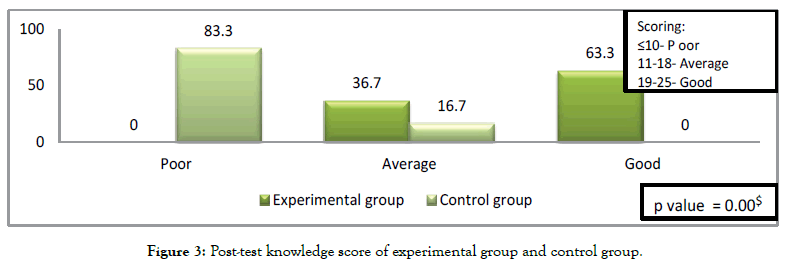
Figure 3. Post-test knowledge score of experimental group and control group.
Comparison of knowledge scores between groups
The groups were comparable in terms of median pretest knowledge scores (p-0.49) (Table 3). There was statistically significant difference (p-0.000) between groups at post-test. Within group, there was statistically significant difference in control group (p-0.0001) and experimental group (p-0.0000). So, there was significantly higher improvement in the knowledge of the group who received the structured patient education programme.
| Pretest Score Median (min-max) |
Post test Score Median (min-max) |
p value | |
|---|---|---|---|
| Experimental group n1=30 |
6 (0,13) | 19 (13, 23) | 0.0000@ |
| Control group n2=30 |
6 (0,13) | 7.5(0,13) | 0.0001@ |
| p value | 0.49* | 0.0000* |
Table 3: Median pretest and post-test scores of groups.
Domain wise knowledge score of groups
Figures 4 and 5, shows the scores of subjects on various domain of anticoagulation knowledge assessment questionnaire.
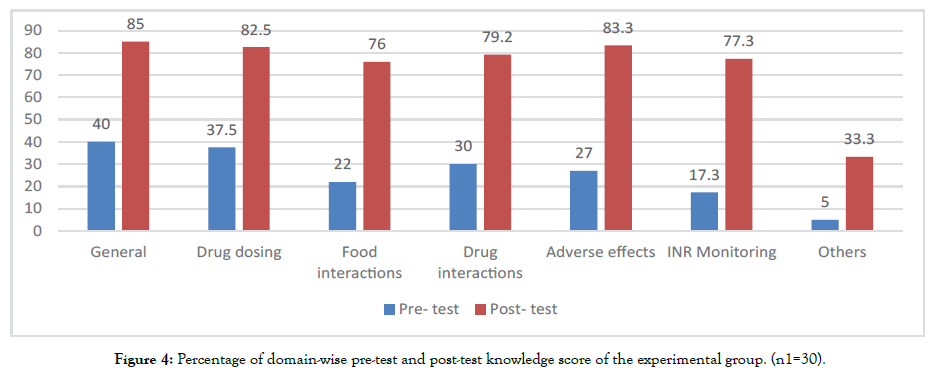
Figure 4. Percentage of domain-wise pre-test and post-test knowledge score of the experimental group. (n1=30).
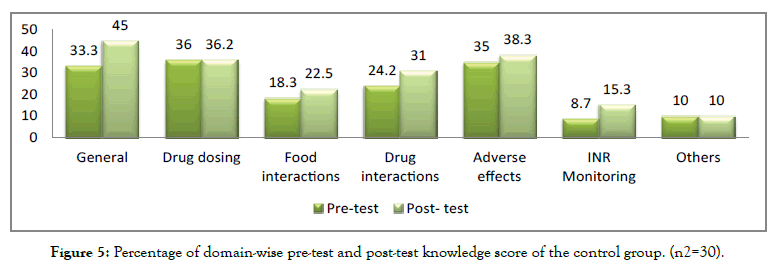
Figure 5. Percentage of domain-wise pre-test and post-test knowledge score of the control group. (n2=30).
Effectiveness of structured patient education programme on the INR control of patients undergoing mechanical valve replacement
Table 4 shows that at 7 days follow-up 20% patients in both experimental and control groups maintain therapeutic whereas 80% patients in both groups were out of the therapeutic range and had either subtherapeutic or supratherapeutic INR.(p=0.65). At 1-month follow-up 23.3% of patients in experimental group and 13.3% in control group maintained therapeutic INR. Supratherapeutic INR in experimental group accounts for 23.3% and in control group 20%. 53.3% in experimental group had subtherapeutic INR as compared to 66.6% in control group (p=0.59). But the difference in the INR control at 7 days and 1-month follow-up in experimental and control group was not statistically significant at a p-value of 0.65 and 0.59 respectively.
| INR Control | Experimental group (n1=30) | Control group (n2=30) | p value |
|---|---|---|---|
| Frequency (%) | Frequency (%) | ||
| 7days follow-up | |||
| Therapeutic INR Supratherapeutic INR Subtherapeutic INR |
6 (20) | 6 (20) | 0.65$ |
| 6 (20) | 9 (30) | ||
| 18 (60) | 15 (50) | ||
| 1-month follow-up | |||
| Therapeutic INR | 7 (23.3) | 4 (13.3) | 0.59$ |
| Supratherapeutic INR | 7(23.3) | 6 (20) | |
| Subtherapeutic INR | 16(53.3) | 20(66.6) | |
Table 4: INR control in groups.
Association of anticoagulation knowledge with other factors
The pre-test (Table 5) knowledge scores were significantly associated with income (p-0.04), residential area (p-0.018) and there was no significant association of pre-test knowledge scores with clinical profile (Table 6). There was no statistically significant association between the post-test scores of experimental and control group with the INR control at 7 days and one month follow-up (Table 7).
| Demographic Variables | Pretest Knowledge Score (%) | p-value | ||
|---|---|---|---|---|
| Poor (<10) | Average (11-18) | |||
| Mean ± SD | Mean ± SD | |||
| Age (yrs) | 42.3±12.2 | 36.8±12.9 | 0.10& | |
| Frequency (%) | Frequency (%) | |||
| Gender | Male Female |
25(84.9) 23(85.2) |
5(15.1) 4(14.8) |
1.00$ |
| Education | Illiterate Primary Education Secondary Education Graduation |
10(100) 13(100) 17(77.3) 11(73.3) |
0(0) 0(0) 5(22.7) 4(26.7) |
0.07$ |
| Monthly income(Rs.) | <5000 5001-15000 15001-30000 >30000 |
16(94.1) 29(87.9) 5(62.5) 1(50) |
1(5.9) 4(12.1) 3(37.5) 1(50) |
0.04$ |
| Marital status | Unmarried Married Widow/Separated |
3(60) 48(87.3) 0(0) |
2(40) 7(12.7) 0(0) |
0.15$ |
| Place of residence | Rural Urban Semirural |
36(92.3) 10(62.5) 5(100) |
3(7.7) 6(37.5) 0(0) |
0.018$ |
Table 5: Association of demographic variables with pre-test knowledge Score.
| Clinical Variables | Pretest Knowledge Score | p value | ||
|---|---|---|---|---|
| Poor (<10) | Average (11-18) | |||
| Frequency (%) | Frequency (%) | |||
| Smoking | Yes No |
11(84.6) 40(85.1) |
2(15.4) 7(14.9) |
0.99$ |
| Alcohol | Yes No |
8(80) 43(86) |
2(20) 7(14) |
0.63$ |
| Any Co-morbidities | Yes No |
21(87.5) 30(83.3) |
3(12.5) 6(16.7) |
0.72$ |
| Any medication use | Yes No |
21(87.5) 30(83.3) |
3(12.5) 6(16.7) |
0.72$ |
Table 6: Association of clinical variables with pre-test knowledge score.
| INR Control | Post-test Knowledge score (Experimental) Frequency (%) (n1=30) | p-value | Post test Knowledge Score (Control) Frequency (%) (n2=30) | p-value | ||||
|---|---|---|---|---|---|---|---|---|
| Poor | Average | Good | Poor | Average | Good | |||
| 7 days follow-up | ||||||||
| Therapeutic INR | 0 (0) | 3(50) | 3(50) | 0.87$ | 5 (83.3) | 1 (16.7) | 0 (0) | 0.12$ |
| Supra-therapeutic INR | 0(0) | 2 (33.3) | 4 (66.7) | 8 (89) | 1 (11) | 0 (0) | ||
| Sub-therapeutic INR | 0(0) | 6 (33.3) | 12 (66.7) | 12(80) | 3(20) | 0 (0) | ||
| Total | 0(0) | 11(36.7) | 19 (63.3) | 25 (83.3) | 5(16.7) | 0 (0) | ||
| 1-month follow-up | ||||||||
| Therapeutic INR | 0(0) | 3 (43) | 4 (57) | 0.48$ | 3 (75) | 1(25) | 0 (0) | 0.36$ |
| Supratherapeutic INR | 0(0) | 1(14.3) | 6 (85.7) | 4 (66.7) | 2 (33.3) | 0 (0) | ||
| Subtherapeutic INR | 0(0) | 7 (43.7) | 9 (56.3) | 18 (90) | 2 (10) | 0 (0) | ||
| Total | 0(0) | 11(36.7) | 19(63.3) | 25 (83.3) | 5 (16.7) | 0 (0) | ||
Table 7: Association of pre and post-test knowledge with INR control.
In the present study, the mean age in experimental group is 41.1± 10.9 and control group is 41.8± 13.7. Majority of the patients in experimental group were males (60%) whereas equal proportion of males (50%) and females (50%) were present in control group. About 43.3% and 30% patients in experimental and control group respectively had secondary education as their educational qualification. 46.7% in experimental group and 63.3% in control group had their monthly income between rupees 5001-15000. Majority of patients in experimental group (93.3%) and control group (90%) were married. Majority of the patients belong to rural area, 66.7% in experimental and 63.3% in control group. The results agreed with Sweta Shrestha et al [18] where 55.9% was male. In agreement with study done by Anu Alphonsa et al [15] reported that mean age was 42.3±14.7 yrs, 56.3% was male, majority had secondary education (45.8%), 83.8% were married and 58% were from rural area. In the present study, majority of the subjects in experimental group (87%) has poor knowledge and control group (83.3%) had poor knowledge. This finding is in concordance with the study done by Sweta Shrestha et al [18], who reported that 94.1% of total participant had inadequate knowledge regarding their anticoagulant therapy and only 5.8% had achieved the minimum satisfactory score and none of the patients achieved 100% score. In the present study, no subject in control group had good knowledge in post-test whereas in experimental group, 63.3% had good knowledge; this finding was in concordance with Amanda R McFee Winans et al [19] which reported that an inpatient warfarin education system significantly improved the knowledge score in intervention group as compared to control group (74% versus 55%) respectively. In the present study, there was no statistically significant in INR control between groups at 7 days follow-up (p-0.65) as well at one month followup (p-0.59), this finding was in agreement with Nichola J Davis et al [20], which reported that only 19% of patients achieved good anticoagulation control and the warfarin knowledge did not affected the anticoagulation control. In disagreement with Sonuga BO et al [21] reported a larger proportion of patients maintaining therapeutic INR 48.5% whereas 51.5% were out of therapeutic range. This can be explained as in the present study patients recently underwent mechanical valve replacement surgery and there is increased warfarin sensitivity in the initial phase after the surgery [22]. The long term outcomes of improved anticoagulation knowledge by structured patient education programme cannot be inferred at 1-month follow-up.
In the present study, there was no statistically significant association between the post-test scores of experimental and control group with the INR control at 7 days follow-up and 1-month follow-up. The results agreed with Poupak Rahmani et al [23] and were in disagreement with Xinggang Li et al [13] where the time spent in therapeutic range of INR was associated with the knowledge score as the study was conducted over a period of 1 year and patients had at least 5 INR values which give a better picture of INR control. Also, in this study a standardized tool for knowledge assessment was used as compared to a self- structured questionnaire used in the present study. In the present study, the pre-test knowledge score of patients is significantly associated with monthly income at a p-value 0.04 and place of residence p-value 0.018. The results agreed with Amanda Hu et al [24] and Anu Alphonsa et al [15].
The strength of the present study lies in well planned educational programme on anticoagulation therapy and recurrent reinforcement. The limitations are as single centred trial, weak experimental design and lack of blinding. Recommendations are as similar studies with longer duration follow-up, strong experimental designs, multicentre study, large sample size and recurrent telephonic reinforcement.
It is concluded from the present study findings that most of the patients maintain poor INR control after mechanical heart valve replacement and had poor knowledge regarding their anticoagulation therapy. A structured patient education programme regarding anticoagulation therapy significantly improved the knowledge of the patients but had no significant effect on INR control. In order to improve anticoagulation control and reduce complications like bleeding and thromboembolism, the educational programme should be implemented in hospital setting.
Citation: Dhindsa H, Sharma A, Parakh N, Devagourou V, Gopichandran L, et al. (2021). Effectiveness of Structured Patient Education Programme on Knowledge Regarding Anticoagulation and INR Control among Patients Undergoing Mechanical Valve Replacement at AIIMS. J Perioper Crit Intensive Care Nurs 7:1. doi:10.35248/2471-9870.21.7.163
Received: 28-Dec-2020 Accepted: 21-Jan-2021 Published: 28-Jan-2021 , DOI: 10.35248/2471-9870.21.7.163
Copyright: © 2021 Dhindsa H. This is an open-access article distributed under the terms of the Creative Commons Attribution License, which permits unrestricted use, distribution, and reproduction in any medium, provided the original author and source are credited.